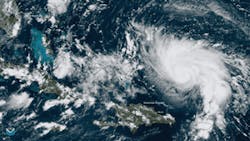5 Best Practices to Adopt for Business Continuity —
With spring comes unfortunate visions of flooded homes, washed out roads, and massive power outages — and these images remain in our minds year after year. Besides the very visible images of destruction, what is not often discussed on a national scale, despite carrying an impact potential that’s greater than the physical devastation, is the damage a hurricane can do to a business’s supply chain.
Figure 1. Wildfire/USFWS/Southeast
Natural disasters and other severe weather events remain a ceaselessly difficult-to-predict risk to business continuity in any supply chain. From the actual suppliers of a business to the transportation routes and delivery services those suppliers use, every link of the chain can be affected by natural disasters, not just hurricanes, but earthquakes, wildfires, floods, tornados, and more. (See Figure 1.)
According to CNBC, AT&T alone announced that several natural disasters cost the telecommunications company $847 million since 2016, including $626 million in 2017 alone. In light of the impact that weather events can have on supply chains, it is critical for businesses to develop detailed contingency plans to lessen the negative effects of such severe weather.
An earlier example is when Hurricane Florence slammed into the North Carolina coast on September 14, 2018, as a Category 1 hurricane. It packed winds of nearly 100 MPH and cloud bands that dumped as much as 30 inches of rain on some areas. As the storm moved up the East Coast, it caused over $38 billion in damage and resulted in flooded roads, closed ports, and major disruptions to air travel and the nation’s rail system.
Florida Braces for Hurricane Dorian / NOAASatellite
More recently, Hurricane Dorian cut a path of catastrophic destruction over parts of the Bahamas in late August and early September of 2019 before targeting the East Coast of the US. As the storm washed out roadways, destroyed major infrastructure, and even damaged an oil facility in the Bahamas, weather forecasters indicated that Florida could sustain a direct hit, resulting in massive evacuations to neighboring states. That alone caused gridlocks on major highways — the same roads used by suppliers to deliver much-needed goods to their business clients. (See Figure 2.)
As the storm began making a turn that eventually led to a path paralleling the coast, Georgia, the Carolinas, and Virginia, began evacuations in coastal areas. Numerous ports and airports throughout the region were closed. Many businesses closed for days. Flights and trains were canceled. Deliveries were delayed by several days, and production in many factories was shut down as employees sought refuge inland, and companies prepared for the worst.
Dorian made landfall over a portion of North Carolina’s Outer Banks on September 6, but the worst physical damage from the storm in the US was limited to barrier islands and some coastal areas. Still, storm preparations disrupted large swaths of the country as transportation routes were either shut down or jammed and production was slowed down or stopped entirely. The multiple shifts in the course of the storm and forecasted landfalls resulted in businesses continually recalculating a response plan and moving assets accordingly. The changing nature of the storm caused the redirecting and delay of ground and sea freight, and numerous business closures and evacuations in the prospective paths of the storm.
InvisiLight® Solution for Deploying Fiber
April 2, 2022Go to Market Faster. Speed up Network Deployment
April 2, 2022Episode 10: Fiber Optic Closure Specs Explained…
April 1, 2022Food for Thought from Our 2022 ICT Visionaries
April 1, 2022Furthermore, throughout the month of October 2019, California was ravaged by at least 13 wildfires, disrupting the entire state and causing widespread power outages and road closures. The devastating fires resulted in over 2 million California residents without power, and over 200,000 were forced to evacuate their homes and businesses.
Due to the breadth of the fires, major roadways closed at various intervals either due to the proximity of a fire or to accommodate evacuation routes, leading to extensive delays and detours for transporters throughout the state, including those traveling to Los Angeles International Airport (LAX).
Throughout the month, power utilities in the state engaged in widespread proactive power outages to attempt to limit the spread of the fire during times of high winds. Early estimates by experts put the economic cost of the early October blackouts in the area of 2 billion dollars. As fires continue to arguably worsen year-to-year, some experts believe that proactive power outages may become a norm in California to mitigate the strength and reach of these wildfires.
5 Best Practices
Although the damage from a natural disaster can rarely be predicted, telcos can take several steps to mitigate the impact such an event can have on them:
Action Item 1
Create a designated operation center.
Businesses with operation centers or designated emergency response teams are able to implement response plans and reallocate assets and employees accordingly, in line with real-time forecasts. These centers help businesses respond to a natural disaster by providing emergency supplies or assistance to impacted facilities. Such coordination and planning measures allows these companies to better minimize the economic impact of a severe weather event, and to rebound quickly after the event.
Action Item 2
During the supplier selection process, factor in the geography around each potentially impacted facility, and any other backup facilities you may operate.
Investigate the defensive measures yoursuppliers have taken (i.e., physical protection from floods), and the history of natural disasters in that area.
Action Item 3
In conducting risk assessments of business partners, you should account for not only the vulnerability and exposure of those partners to natural disasters, but also the ability to recover quickly from severe weather.
Resiliency to natural disasters, primarily the ability to repair and replace infrastructure, as well as the availability of alternative shipping lanes and facilities, are critical in any evaluation of a prospective supply chain.
You should also learn which suppliers have operations in places that are prone to natural disasters. Create a map that marks the location of your suppliers, and highlight their delivery routes. You’ll also want to select alternate routes your suppliers can take in the event of mass evacuations or other issues caused by a disaster.
Action Item 4
Make a list of potential issues that can disrupt your supply chain.
This should include things such as flooding, mudslides, washed out roads, destroyed or otherwise closed bridges, massive traffic jams, power outages, impassable roads due to blizzards, damaged rail lines, airports that are shut down, etc.
Action Item 5
Prioritize your suppliers — and your supplies — ahead of time.
• Which suppliers are absolutely essential to keeping your business going in the short term?
• Which ones are less important, and make deliveries on a monthly basis rather than daily or weekly?
In planning for the unexpected, ensure your business has a list of the necessary number of products and materials to continue business in light of a distribution for x-amount of time. Keep this list and review it once a quarter, adjusting as needed, as part of your business continuity plan.
Being Prepared = Resiliency
A good business, regardless of the number of commas on its financial statements, should be prepared for myriad scenarios related to its supply chain. By instilling common procedures and protocols throughout the supply chain for reacting to natural disasters and other severe weather phenomena, companies can be better prepared to mitigate the disruption and damage to the supply chain.
Natural disasters will strike — but with proper protocols in place, your business can remain resilient and minimize risk during the unexpected.
Like this Article?
Subscribe to ISE magazine and start receiving your FREE monthly copy today!
Resource
AT&T, hit by higher natural disaster costs, unveils 30-year climate change model, by Emma Newburger, CNBC, published Wed, Mar 27 2019. https://www.cnbc.com/2019/03/27/att-hit-by-higher-natural-disaster-costs-unveils-30-year-climate-change-model.html. Retrieved 021320.
About the Author







